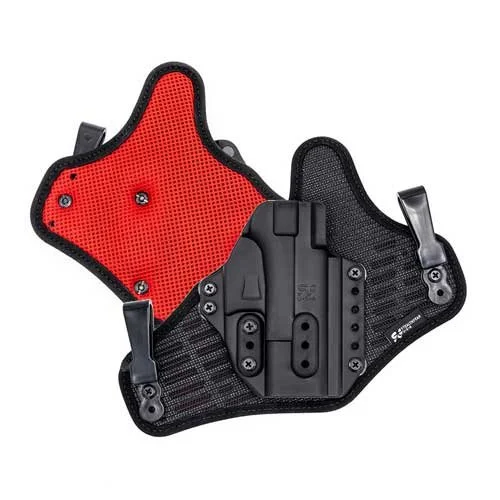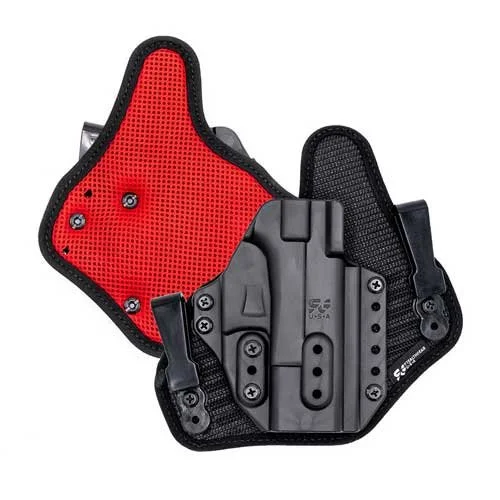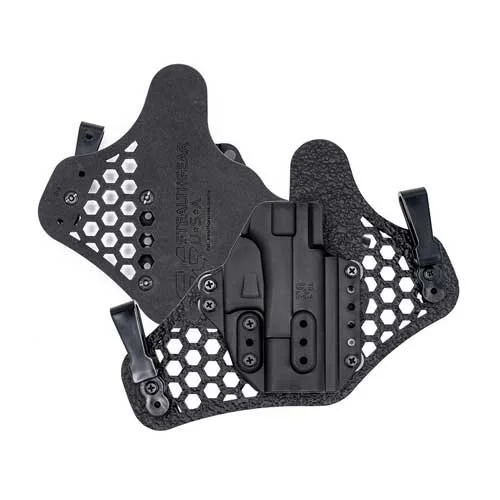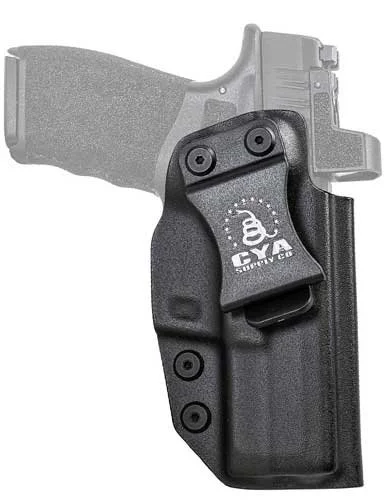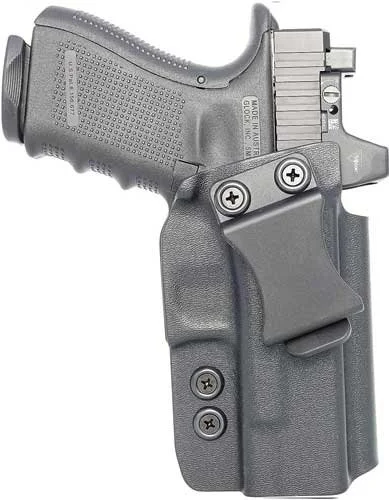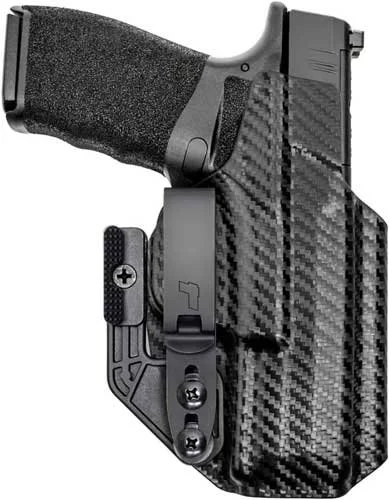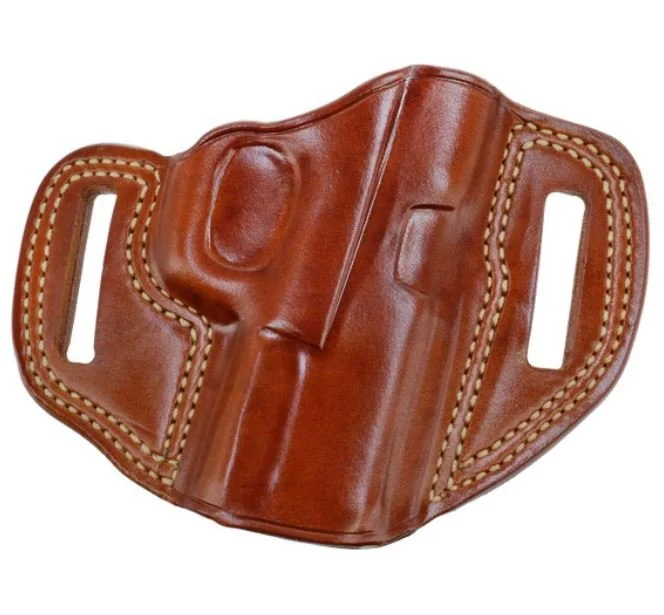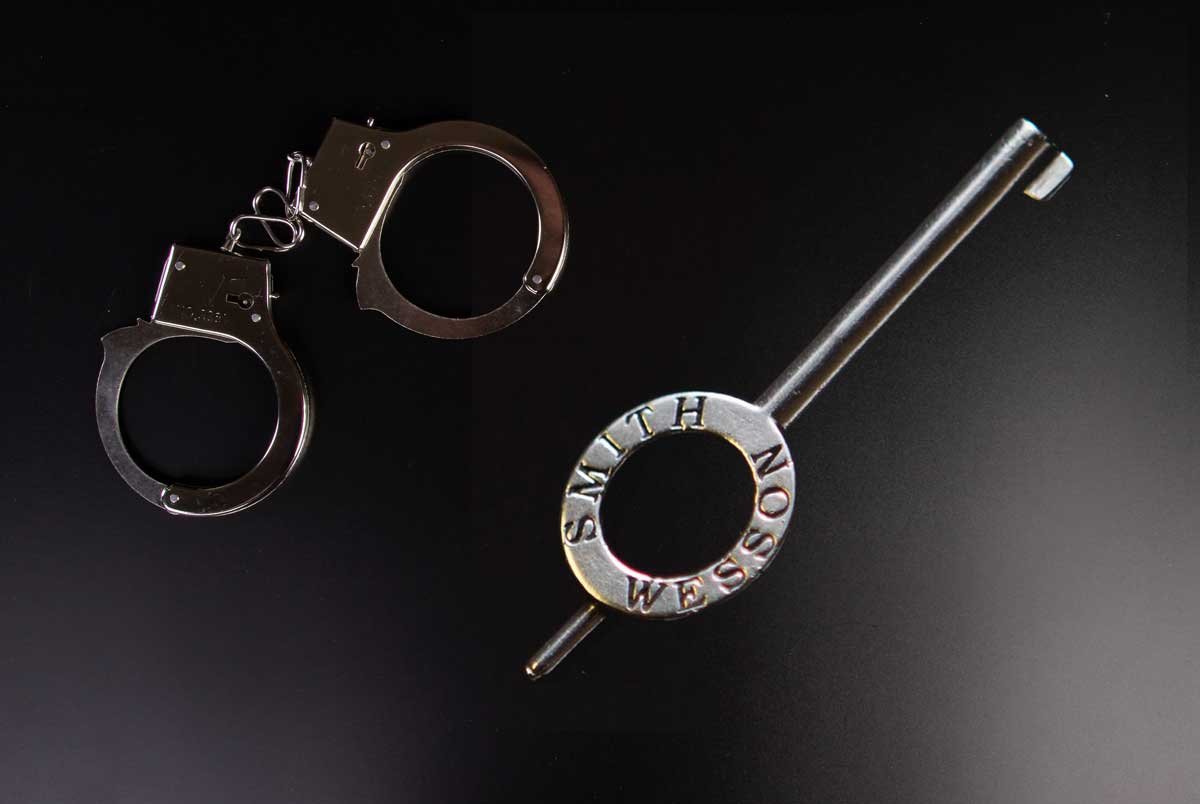
Best Holster for
Hellcat Pro
Securing Excellence: The Ultimate Guide to Hellcat Pro Holsters
Finding the perfect holster for your Springfield Hellcat Pro is an essential step towards confident and comfortable concealed carry.
With a multitude of options available, it can be a daunting task to narrow down the choices.
In this comprehensive guide, we'll help you navigate through the sea of possibilities and provide you with expert insights to aid in your decision-making process.
Whether you prioritize comfort, accessibility, or concealment, our buyer's guides and handpicked holster recommendations will assist you in selecting the ideal companion for your Hellcat Pro.
Join us as we explore the top contenders in the holster market, ensuring that your everyday carry experience remains both secure and hassle-free.
Disclaimer: This blog post contains affiliate links. If you make a purchase through one of these links, we may receive a small commission at no additional cost to you.
This helps support our work and allows us to continue providing valuable content. Thank you for your support!
Best Overall:
StealthGearUSA
-
StealthGearUSA is one of the world’s premier holster manufacturers. Entirely made in the USA, their products are innovative, built to last, and backed by a lifetime warranty.
-
Ventcore technology delivers premium all-day comfort via a laser-cut internal core for maximum breathability and a high-performance mesh backing that wicks moisture away from the body.
This technology allows the area of your body that sits against the holster to breathe for all-day comfort, in virtually any environment or weather.
-
• Ventcore platform design increases airflow for even greater all-day comfort
• Red dot optic, suppressor sight, and threaded barrel/compensator compatible
• 15-degree cant (adjustable)
• Custom designed and fit to the Springfield Hellcat Pro
• 100% trigger guard coverage
• Hand-built in the USA
Other Options:
When it comes to concealed carry, comfort, security, and precision matter.
StealthGearUSA has, since 2012, been the beacon of innovation in the concealment gear market, developing breakthroughs that are nothing short of revolutionary.
Ventcore IWB Mini
Ventcore Appendix
Ultralite IWB
Amazon Best Sellers:
All options are made in the USA and are backed by lifetime warranties.
As an Amazon Associate, I earn from qualifying purchases.
CYA Supply Co.
Retention: Adjustable
Cant: Adjustable (0°→15°)
Many options available
Sweat Guard
Made in USA
Concealment Express
Retention: Adjustable
Cant: Adjustable (-5°→20°)
Sweat Guard
Made in USA
Tulster Oath
Retention: Adjustable
Cant: 0° (Vertical)
Sweat Guard
Made in USA
Lifetime Warranty
Leather:
Experience the legacy of excellence with Galco Leather Holsters.
Since 1969, Galco has upheld the highest standards of quality, hand crafting premium holsters from saddle leather, horsehide, and more.
Trusted by law enforcement, military, and armed citizens worldwide, Galco stands for the best in performance and innovation.
Galco Combat Master
• Premium steerhide
• Precision molded to the Hellcat Pro
• Butt-forward cant
• Traditional pancake design
• Fits belts up to 1 3/4"
Quick Links:
StealthGearUSA:
Ventcore 2.0 Standard - The ultimate holster for comfort and breathability for all-day wear.
Ventcore 2.0 Mini - The same technology in a smaller, lighter-weight package.
Ventcore 2.0 Appendix - The same technology adapted for appendix carry.
Ultralite IWB - ACX-57: Tough, Flexible, Waterproof – Uncompromising Comfort and Durability with Laser-Cut Honeycomb Breathability.
Other USA Options:
CYA Supply Co. - precision-crafted, backed by a lifetime warranty, featuring adjustable retention, cant, and full sweat guard, perfect for everyday carry. Made in USA.
Concealment Express - expertly molded, adjustable cant and retention, complete concealment, unbeatable quality, lifetime warranty. Made in USA.
Tulster Oath - Optic-ready, ambidextrous, tuckable, lifetime warranty. Made in USA.
Leather:
Galco Combat Master Belt Holster - Legendary leather quality OWB holster from Galco. Not compatible with optics.
Recent Posts:
Buyer’s Guide
The Springfield Armory Hellcat Pro is a versatile and powerful concealed carry handgun.
When looking for a holster to carry your Hellcat Pro, there are numerous factors to consider to ensure you're getting the right fit, security, and accessibility for your firearm.
Here's a comprehensive guide to assist you in making an informed decision.
1. Types of Holsters:
Inner Waistband (IWB): Popular for concealed carry, IWB holsters sit inside your pants, with only the clip or attachment mechanism visible outside. They provide excellent concealment but may require pants a size larger for comfort.
Outside Waistband (OWB): These are worn on the outside of your pants. OWB holsters are often easier to draw from, but they're less concealed than IWB options.
Pocket Holsters: For deep concealment, a pocket holster may be ideal. Ensure the holster keeps the gun oriented correctly and blocks the trigger.
Ankle Holsters: Best for a backup gun, ankle holsters are not ideal for your primary firearm due to their difficult accessibility.
Shoulder Holsters: They distribute the gun’s weight across your shoulders. It's essential to practice drawing from this style as it's different from hip holsters.
Belly Bands: These wrap around your abdomen and can carry a firearm either appendix style or on the side.
-
1. Inner Waistband (IWB) Holsters
Pros:
Offers deep concealment making it harder to detect the firearm.
Flexible positioning: can be placed appendix, 3 o'clock, or small of the back.
Great for concealed carry permit holders.
Cons:
Can be uncomfortable when sitting for prolonged periods.
Might require you to wear pants a size up.
Potential wear on firearm finish due to close body contact.
2. Outer Waistband (OWB) Holsters
Pros:
Quick and easy draw.
More comfortable for extended wear.
Available in different styles like paddle and belt loop.
Cons:
Less concealable than IWB, may require a jacket or untucked shirt.
Can snag on objects if not careful.
3. Pocket Holsters
Pros:
Highly concealable and discreet.
Ideal for situations where deep concealment is essential.
Cons:
Not suitable for quick draw situations.
Must ensure that no other objects are in the pocket.
4. Appendix Inner Waistband (AIWB) Holsters
Pros:
Quick access to firearm.
Concealable even with a tucked-in shirt.
Cons:
Potential discomfort when sitting.
Safety concerns if not used correctly.
5. Shoulder Holsters
Pros:
Distributes weight across the shoulders.
Ideal for those who sit for prolonged periods.
Accessible when driving.
Cons:
Requires practice to draw safely.
Harder to conceal unless wearing a jacket.
6. Ankle Holsters
Pros:
Ideal for backup firearms.
Less likely to be detected in a pat-down.
Cons:
Challenging and slow to draw from.
Can be uncomfortable.
7. Belly Band Holsters
Pros:
Versatile placement options around the waist.
Great for activewear and outfits without a belt.
Cons:
Can get warm and sweaty.
Slower draw compared to traditional holsters.
8. Off-body Holster (Bags, Purses, etc.)
Pros:
Ideal for those who can't or don't want to carry on their person.
Can also carry extra ammunition or other EDC items.
Cons:
Slower access to firearm.
Security concern if the bag is stolen or misplaced.
Recommendations:
Always prioritize safety. Any holster you choose should completely cover the trigger guard and securely retain the firearm.
Factor in your daily activities. For instance, if you spend a lot of time driving, a shoulder or appendix holster might be preferable.
Regularly practice drawing and holstering your Hellcat Pro with the holster you select.
2. Material:
Leather: Classic, comfortable, and molds to the gun over time. However, it can retain moisture and may lose its shape.
Kydex: A plastic material that offers a precise fit to your firearm. It's durable and maintains its shape but can be less comfortable against the skin.
Hybrid: Combines the best of both worlds. Usually, it has a leather backing for comfort with a Kydex shell for firearm retention.
Nylon: Often more affordable, but may not provide as secure a fit as Kydex or leather.
-
1. Leather Holsters
Pros:
Aesthetics: Leather has a classic, timeless look that many gun enthusiasts appreciate.
Comfort: Over time, leather molds to the contours of the firearm and your body, offering a custom fit.
Durability: A well-maintained leather holster can last for decades.
Cons:
Maintenance: Requires regular cleaning and conditioning to prevent drying or cracking.
Moisture Retention: Can retain sweat, potentially leading to corrosion on your firearm.
Break-in Period: Might be tight initially and requires some time to achieve an optimal fit.
2. Kydex Holsters
Pros:
Durability: Resistant to moisture, sweat, and chemicals.
Consistency: Retains its shape over time, ensuring a consistent draw.
Adjustable Retention: Many Kydex holsters allow you to adjust the retention level for a customized fit.
Cons:
Comfort: Can be rigid and less comfortable against the body compared to leather.
Wear on Firearm: The hard material might cause faster wear on the firearm's finish.
3. Hybrid Holsters (Leather/Kydex combination)
Pros:
Comfort: Combines the comfort of leather against the body with the retention and durability of Kydex for the gun.
Adjustability: Often offers adjustable retention and cant.
Best of Both Worlds: Retains the firearm securely while being gentle against the body.
Cons:
Bulk: Can be slightly bulkier than pure Kydex or leather holsters.
Maintenance: Still requires leather care for the leather portion.
4. Nylon Holsters
Pros:
Affordability: Generally less expensive than leather or Kydex holsters.
Flexibility: Can adjust to various firearm sizes.
Lightweight: Often lighter than other holster types.
Cons:
Durability: Might not be as durable as leather or Kydex.
Retention: Doesn't offer the molded, precise fit of Kydex, potentially leading to less secure retention.
5. Neoprene and Soft Fabrics (common in belly bands or pocket holsters)
Pros:
Comfort: Soft against the skin, ideal for jogging or athletic activities.
Versatility: Can be worn in various positions on the body.
Cons:
Retention: Doesn't offer the same level of firearm retention as harder materials.
Durability: Over time, soft fabrics may stretch or wear out.
Recommendations:
Consider Your Activities: If you're frequently outdoors or sweating, a Kydex or hybrid holster might be preferable due to moisture resistance.
Maintenance Commitment: If you're not keen on regular maintenance, leather might not be the best choice.
Carry Position: Some materials are better suited for specific carry positions. For instance, neoprene is great for belly bands, while Kydex excels in OWB configurations.
Budget: If you're on a tight budget, nylon might be a good starting point. However, investing in a high-quality leather or Kydex holster can be cost-effective in the long run due to its durability.
3. Retention:
Level I: Uses friction to keep the gun in place.
Level II: Has an additional retention device like a thumb break strap.
Level III or higher: Offers additional mechanisms like hood guards or release buttons. Ideal for duty use.
-
1. Why Retention Matters
Safety: A good retention system prevents accidental discharges by ensuring the firearm cannot be easily jostled or manipulated.
Prevention of Theft or Unauthorized Access: The harder it is to remove a firearm from a holster, the less likely it is to be taken by an assailant or curious child.
Ease of Activity: With proper retention, you can move freely without concern about your firearm falling out.
2. Levels of Retention
Retention is often categorized by "levels," which refer to the number of mechanisms or actions required to draw the firearm:
Level I: Passive retention. This typically means the holster relies on friction to keep the firearm in place. Adjustability in the tightness allows for a customized fit.
Level II: One active retention device in addition to passive retention. This could be a thumb break strap, a push-button release, or a hood over the back of the gun slide.
Level III: Two active retention devices. This might combine a thumb break with a push-button mechanism.
Level IV and higher: Rare and typically involve multiple active retention systems and mechanisms.
3. Types of Retention Mechanisms
Friction: Passive retention where the holster material's tension holds the firearm. Many holsters offer adjustable screws to increase or decrease this friction.
Thumb Break/Strap: A leather or nylon strap that goes over the back of the gun's grip or slide. Releasing the firearm requires a snap or button to be pressed.
Push-button or Lever Release: Often found on Kydex holsters, requiring the user to press a button or lever to release the firearm.
Hood Guard: Common in duty holsters, this is a protective cover that flips over the back of the firearm, preventing direct access.
Grip Lock System (GLS): The mechanism engages with the grip, and the user deactivates it with a natural grip motion during the draw.
4. Factors to Consider
Personal Comfort with Retention: It's crucial to find a balance between security and the ability to quickly draw your firearm. More retention can mean a slower draw.
Training: The more retention devices you have, the more training is required to ensure you can efficiently draw under stress.
Environment: In high-risk areas or situations where someone might try to grab your firearm, higher retention is beneficial.
Activity Level: If you're involved in rigorous activities, stronger retention may be necessary to ensure the firearm stays put.
5. Recommendations
Consistent Practice: Whichever level of retention you choose, regular practice is essential. This ensures muscle memory develops, allowing for a quick and smooth draw when needed.
Test in Real-Life Situations: Move, run, and try various positions to ensure the retention is adequate for your daily activities.
Prioritize Safety: Always ensure that the retention mechanisms don't interfere with the firearm's trigger.
4. Ride Height and Cant:
Ride Height: Refers to how high or low the gun sits in relation to your belt line.
Cant: The angle at which the gun is carried. Some prefer a forward cant for easier drawing.
-
1. Ride Height
Ride height refers to how high or low the firearm sits concerning the waistband or belt when holstered.
High Ride: The firearm sits higher up, with the grip well above the belt line.
Pros:
Easier grip access and faster draw.
Reduced chance of the firearm digging into seats or furniture when sitting.
Cons:
May be less concealable, as the grip protrudes more.
Potential for decreased stability if not secured properly.
Mid Ride: The firearm sits at a moderate level, with the grip nearly level with the belt.
Pros:
Balance of concealability and accessibility.
Stable and comfortable for many users.
Cons:
Might still dig into seats for some users.
Low Ride: The firearm sits lower, with the grip close to or below the belt line.
Pros:
Enhanced concealability as most of the firearm is beneath the belt line.
Suitable for deep concealment purposes.
Cons:
Slower draw due to decreased grip accessibility.
Potential discomfort when sitting.
2. Cant
Cant refers to the angle at which the firearm sits in the holster. It's usually measured in degrees from the vertical position.
Zero Cant (Vertical):
Pros:
Natural draw in the straight-up position.
Can be comfortable when standing.
Cons:
May print more, especially with longer barrels.
Potential discomfort when seated, especially in the car.
Forward Cant (Typically 10-20 degrees):
Pros:
Aids in concealability, especially for larger firearms.
Ergonomic draw for many, especially from behind the hip.
Cons:
Can be less intuitive for new carriers until practiced.
Reverse Cant:
Pros:
Useful for cross-draw situations like driving.
Cons:
Not commonly used for standard IWB or OWB carry due to draw angle.
Recommendations:
Body Type and Positioning: Your body shape can influence which ride height and cant are most comfortable. For instance, those with a more athletic build might find a forward cant more comfortable, while a high ride might suit those with a leaner frame.
Intended Carry Position: If you prefer appendix carry, a neutral cant might be best. For carrying at the 3-5 o'clock position, a forward cant could be more ergonomic.
Activity Level: If you're frequently seated, consider the implications of ride height and cant for comfort. Those on the move might prioritize accessibility and stability.
Practice: Whichever combination of ride height and cant you choose, practice drawing and holstering. The best configuration will offer a blend of comfort, concealability, and quick access.
5. Features to Look For:
Adjustability: The ability to adjust the cant, ride height, or retention can make a holster more versatile and comfortable.
Sweat Guard: This keeps the gun from touching your skin, providing comfort and preventing corrosion.
Ease of Attachment: Consider how easily you can put on or take off the holster.
-
1. Retention Systems:
Adjustable Retention: The ability to customize how tightly the holster grips the firearm ensures both security and ease of draw.
Positive “Click” or Feedback: Some holsters provide audible or tactile feedback when the firearm is securely seated.
2. Ride Height and Cant Adjustability:
Multiple Ride Heights: Look for holsters that allow you to adjust how high or low your firearm sits.
Varied Cant Angles: The ability to adjust the angle can help you find the most ergonomic draw angle for your preferred carry position.
3. Comfort Features:
Padded Backing: For IWB holsters, a padded or cushioned backing can enhance comfort against the skin.
Breathable Materials: Materials like neoprene or vented backing can reduce sweat and increase comfort during prolonged wear.
4. Durability and Protection:
Quality Materials: Whether Kydex, leather, or hybrid, ensure the materials are high-grade and durable.
Sweat Guard: A barrier between you and the firearm can help protect the gun from corrosion due to sweat.
Reinforced Mouth: A holster with a reinforced opening ensures easier re-holstering and maintains its shape over time.
5. Modularity and Versatility:
Convertible Design: Some holsters can be converted between IWB and OWB, offering versatility.
Attachment Options: Being able to switch between clips, loops, or other attachment methods can be beneficial for varied use-cases.
6. Concealability:
Tuckable Clips: For those who wear shirts tucked in, tuckable clips allow the shirt to be tucked over the firearm and holster, with only the clip visible over the belt.
Low-Profile Design: Slim designs with minimal excess material can reduce printing and enhance concealment.
7. Accessibility and Draw:
Cut-Outs for Faster Draw: A holster with a cut near the grip can ensure a quicker and more secure grip when drawing.
Smooth Interior: A smooth interior will minimize wear on your Hellcat Pro's finish and ensure a smooth draw.
8. Safety Features:
Trigger Guard Coverage: Full coverage of the trigger area is crucial to prevent any accidental discharges.
Positive Locking System: Mechanisms that ensure the gun remains securely holstered until intentionally drawn can be a valuable safety feature, especially in situations where there might be a risk of the gun being grabbed.
9. Aesthetics:
Visual Appeal: While functionality is paramount, many gun enthusiasts also appreciate holsters that look good.
Customizable Options: Some brands offer customizable colors, patterns, or designs, allowing you to personalize your holster.
10. After-Sale Support:
Warranty: A robust warranty can be an indicator of a company's faith in its product.
Customer Service: Quality customer support can make a difference, especially if you have questions or issues.
Recommendations:
Prioritize Safety: Always ensure that the holster fully covers the trigger and holds the firearm securely.
Consider Daily Activities: Think about how you'll spend most of your day (sitting, walking, driving) and select features that cater to these activities.
Test and Train: Once you select a holster, spend ample time practicing your draw and re-holstering to become familiar with its features and quirks.
6. Trusted Holster Brands:
StealthGearUSA
CYA Supply Co.
Concealment Express
Tulster
Galco Gunleather
7. Price:
Holster prices can vary widely, from under $20 to well over $100. Often, you get what you pay for in terms of quality and durability, but there are budget options that provide good value.
8. Final Tips:
Always practice drawing and re-holstering with an unloaded firearm initially.
Consider your daily activities and wardrobe when choosing a holster.
Remember, safety is paramount. Ensure the holster covers the trigger guard completely.
Conclusion:
In the world of concealed carry, finding the perfect holster for your Springfield Hellcat Pro is an essential step towards carrying with confidence.
After delving into various options, we've compiled comprehensive buyer's guides and expert insights to help you make an informed decision.
Whether you're prioritizing comfort, accessibility, or concealment, our recommendations cover a range of preferences to suit your needs.
Top Picks:
StealthGearUSA:
Ventcore 2.0 Standard - The ultimate holster for comfort and breathability for all-day wear.
Ventcore 2.0 Mini - The same technology in a smaller, lighter-weight package.
Ventcore 2.0 Appendix - The same technology adapted for appendix carry.
Ultralite IWB - ACX-57: Tough, Flexible, Waterproof – Uncompromising Comfort and Durability with Laser-Cut Honeycomb Breathability.
Other USA Options:
CYA Supply Co. - precision-crafted, backed by a lifetime warranty, featuring adjustable retention, cant, and full sweat guard, perfect for everyday carry. Made in USA.
Concealment Express - expertly molded, adjustable cant and retention, complete concealment, unbeatable quality, lifetime warranty. Made in USA.
Tulster Oath - Optic-ready, ambidextrous, tuckable, lifetime warranty. Made in USA.


